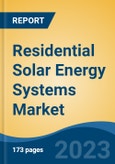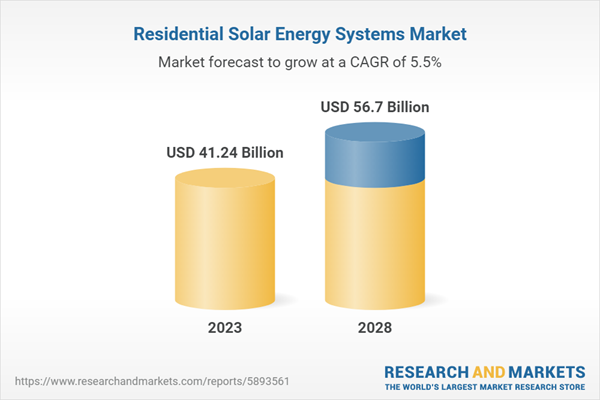Speak directly to the analyst to clarify any post sales queries you may have.
10% Free customizationThis report comes with 10% free customization, enabling you to add data that meets your specific business needs.
Solar energy is defined as the energy obtained from solar radiation, which can be used and transformed into different forms of energy, that is electrical energy and heat energy. This energy is abundant and renewable, making it an attractive replacement to traditional fossil fuels, which are finite and add to climate change. Solar energy can be employed through various technologies, including solar cells that change sunlight directly into electricity, or concentrated solar energy systems. Also, utilize the heat of the sun to conduct electricity or hot water for various purposes. There are various advantages of using solar energy including reducing dependence on fossil fuels, more sustainable energy and reducing greenhouse gas emissions.
Declining Price and Installation Cost of Solar PV Systems
The average cost of a solar PV panel has dropped globally by approximately 90% as compared to the last decade. The prices of more components have dropped considerably since 2011, reducing the Levelized Cost of Electricity (LCOE) for both residential and utility-scale solar PV generation. There are techno-economic and geopolitical factors which are estimated that solar PV panel prices is going to reduce slightly. Additionally, the price is expected to decline in the forecast period. The United States National Renewables Energy Laboratory stated that there has been a reduction in the cost of residential rooftop, commercial, and utility-scale PV systems by 64%, 82% and 69% since 2010. The decline in the prices of solar panels in the United States and Europe are majorly due to the decrease in the price of solar panels. Thus, it is expected to rise in the market of solar energy and drive the demand for solar energy in these regions. Furthermore, many residential and commercial consumers opt for rooftop solar PV systems to reduce energy costs and recovery time due to a decline in prices as lower panel costs enable us to sign of Power Purchase Agreements (PPA) with consumers at a lower cost for large-scale utility project operators.Investment in Renewable Energy
The global residential solar energy market is projected to grow due to rising investments in infrastructure of renewable energy sources and favorable government laws and subsidies to support innovative new technology across the region. Additionally, there is a wide range of countries including the United States, Canada, India, China, Saudi Arabia, Australia, and Mexico, etc. increasing their investment in the renewable energy industry and focusing on clean energy & declining carbon emission by the end of 2050, as per the Paris Agreement. For instance,- In September 2021, the United States government, passed a bill worth USD 550 billion big investment in clean energy including USD 73 billion allotted for clean energy generation, and USD 7.5 billion for electric vehicles among others and aimed to enhance the clean energy landscape in the country. Furthermore, according to the American Clean Power Association (ACPA), 26 GW of clean energy projects came in last year.
- In April 2022, Canada Government invested around USD 300 million in clean energy projects in indigenous, rural and remote communities across the country. These initiatives help to produce dependable heat and power for future generations while reducing the usage of fossil fuels energy to keep the air and land clean.
- In May 2022, The UAE invested over than USD 40 billion in clean energy over the past 15 years and planned to invest an additional USD 160 billion in clean and renewable energy over the next three decades to achieve net zero.
- In October 2022, The Qatar Investment Authority invested USD 2.43 billion in Germany’s largest power producer RWE AG, to help it buy US firm Con Edison Inc’s Clean Energy Businesses subsidiary for USD 6.8 billion.
Increasing Focus on Low Carbon Emissions
The rising focus on low carbon emissions has a direct influence on the residential solar energy market. The Paris Agreement is focused on reducing the emission of CO2 by enhancing the usage of solar and renewable energy. The adoption of solar energy helps to decrease the dependence on other forms of energy including fossil fuels, coal, and oil, allowing market players to produce electricity from a renewable energy source. Furthermore, In addition, the employ of solar energy has the additional benefit of regulating temperatures and lowering stress on cooling systems and air-conditioners in commercial and industrial settings. Currently, with the increasing demand for cost-effective energy solutions and low-emission, solar energy is becoming an increasingly attractive option for businesses. The utilization of solar energy raises environmental sustainability, disaster resilience, and efforts to oppose climate change. Also, Rapid global phase-out of coal to decrease costs and accomplish low-carbon objectives. The adoption of clean renewable energy has increased. Also, this includes improving air quality by promoting rural development with off-grid electricity using solar energy. Thus, the produced energy is then utilized to generate electricity or can be collected in batteries. Therefore, these various types of applications are expected to enhance the demand for solar energy globally. In some cases, the price of renewable energy is competitive, and unsubsidized renewable energy is likely to be less expensive as compared to new conventional generators. Thus, above mentioned factors enhance the need for solar energy rises along with the need for sustainable energy systems.Market Segmentation
The global residential solar energy market is segmented based on product type, service, and regions. Based on product type, the market is segmented into solar panels, solar batteries, and solar inverters. Furthermore, the solar panels segment is fragmented into monocrystalline, polycrystalline, and thin film. Solar inverters segment is sub-divided into central, string, and micro. The solar batteries segment is sub-segmented into lithium ion, lead acid, and flow battery. Based on service, the market is segmented into new installation, and maintenance & repair. The market analysis studies the regional segmentation divided among North America, Europe, Asia-Pacific, South America, and Middle East & Africa.Company Profiles
Canadian Solar Inc., JinkoSolar Holding Co. Ltd, Trina Solar Co. Ltd, LONGi Green Energy Technology Co. Ltd, JA Solar Holding, Abengoa SA, NextEra Energy Inc, Sharp Corporation, Hanwha Corporation, First Solar Inc. among others the major players that are driving the growth of the global residential solar energy market.Report Scope:
In this report, the global residential solar energy market has been segmented into the following categories, in addition to the industry trends which have also been detailed below:Residential Solar Energy Market, By Product Type:
- Solar Panels
- Monocrystalline
- Polycrystalline
- Thin Film
- Solar Inverters
- Central
- String
- Micro
- Solar Batteries
- Lithium Ion
- Lead Acid
- Flow Battery
Residential Solar Energy Market, By Service:
- New Installation
- Maintenance & Repair
Residential Solar Energy Market, By Region:
- Asia-Pacific
- China
- Japan
- India
- Australia
- South Korea
- North America
- United States
- Canada
- Mexico
- Europe
- United Kingdom
- Germany
- France
- Spain
- Italy
- Middle East & Africa
- Israel
- Turkey
- Saudi Arabia
- UAE
- South America
- Brazil
- Argentina
- Colombia
Competitive Landscape
Company Profiles: Detailed analysis of the major companies present in the global residential solar energy market.Available Customizations:
With the given market data, the publisher offers customizations according to a company’s specific needs.This product will be delivered within 1-3 business days.
Table of Contents
Companies Mentioned
- Canadian Solar Inc.
- JinkoSolar Holding Co. Ltd
- Trina Solar Co. Ltd
- LONGi Green Energy Technology Co. Ltd
- JA Solar Holding
- Abengoa SA
- NextEra Energy Inc
- Sharp Corporation
- Hanwha Corporation
- First Solar Inc.
Table Information
| Report Attribute | Details |
|---|---|
| No. of Pages | 173 |
| Published | October 2023 |
| Forecast Period | 2023 - 2028 |
| Estimated Market Value ( USD | $ 41.24 Billion |
| Forecasted Market Value ( USD | $ 56.7 Billion |
| Compound Annual Growth Rate | 5.4% |
| Regions Covered | Global |
| No. of Companies Mentioned | 10 |









